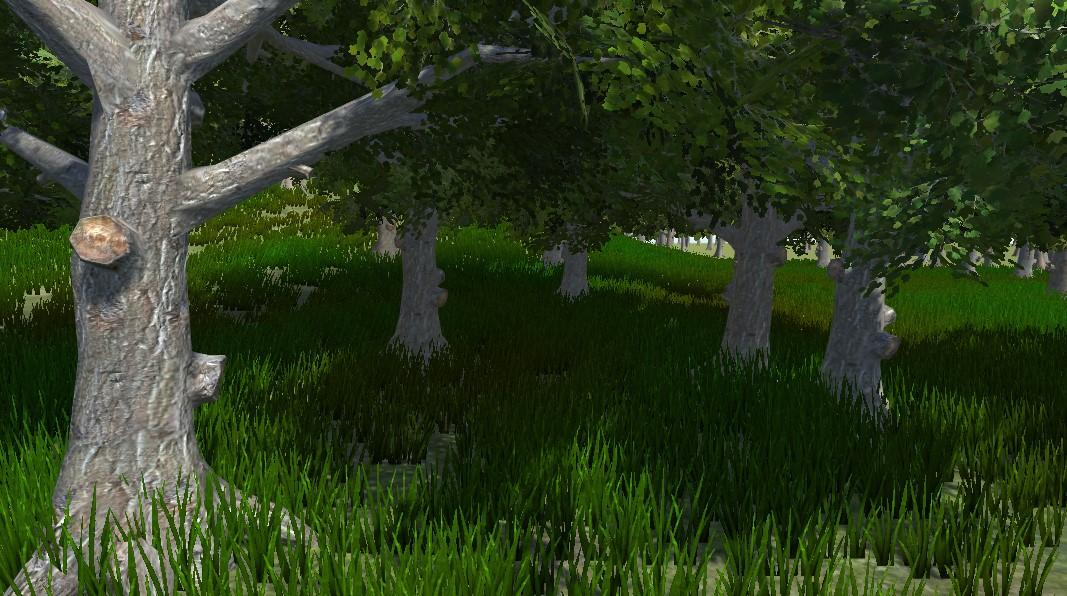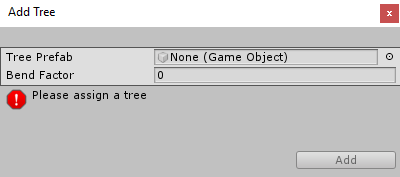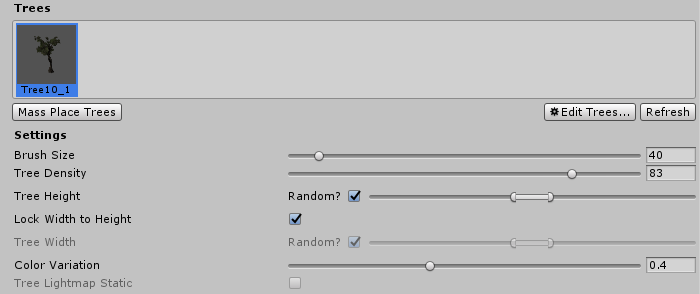Trees
You can paint Trees onto a Terrain in a way that is similar to painting heightmapsA greyscale Texture that stores height data for an object. Each pixel stores the height difference perpendicular to the face that pixel represents.
See in Glossary and textures. However, Trees are solid 3D objects that grow from the surface. Unity uses optimizations like billboardingThe process of constantly altering the 2D object’s rotation so that it always faces the Camera. Billboarding is often used as a level-of-detail method for objects far away from the Camera. See Billboard Renderer
See in Glossary for distant Trees to maintain good renderingThe process of drawing graphics to the screen (or to a render texture). By default, the main camera in Unity renders its view to the screen. More info
See in Glossary performance. This means that you can have dense forests with thousands of trees, and still keep an acceptable frame rate.

Painting Trees
The Paint Trees button on the toolbarA row of buttons and basic controls at the top of the Unity Editor that allows you to interact with the Editor in various ways (e.g. scaling, translation). More info
See in Glossary enables Tree painting:

Initially, the Terrain has no tree prototypes available. To start painting onto the Terrain, you need to add a tree prototype. Click the Edit Trees button, and select Add Tree. From here, you can select a Tree AssetAny media or data that can be used in your game or Project. An asset may come from a file created outside of Unity, such as a 3D model, an audio file or an image. You can also create some asset types in Unity, such as an Animator Controller, an Audio Mixer or a Render Texture. More info
See in Glossary from your Project, and add it as a Tree Prefab for use with the brush:

To help prototyping, SpeedTree provides four SpeedTree models in the free SpeedTrees Package on the Asset StoreA growing library of free and commercial assets created by Unity and members of the community. Offers a wide variety of assets, from textures, models and animations to whole Project examples, tutorials and Editor extensions. More info
See in Glossary. Alternatively, you can create your own Trees.
If the Tree PrefabAn asset type that allows you to store a GameObject complete with components and properties. The prefab acts as a template from which you can create new object instances in the scene. More info
See in Glossary that you are importing supports Bend Factor, the Add Tree window displays a Bend Factor property for adjusting wind responsiveness. Trees created with the SpeedTree Modeler don’t have a Bend Factor; only those created with Tree Editor do. See the section on Making Trees bend in the wind, below.
When you have configured your Settings (described below), you can paint Trees onto the Terrain in the same way you paint textures or heightmaps. To remove Trees from an area, hold the Shift key while you paint. To remove just the currently selected Tree type, hold down the Control key while you paint.
Settings
After you select which Tree to place, adjust its settings to customize Tree placement and characteristics.

| Property: | Function: |
|---|---|
| Mass Place Trees | Create an overall covering of Trees without painting over the whole landscape. After mass placement, you can still use painting to add or remove Trees to create denser or sparser areas. |
| Brush Size | Controls the size of the area that you can add Trees to. |
| Tree Density | Tree Density controls the average number of Trees painted onto the area defined by Brush Size. |
| Tree Height | Control the Tree’s minimal height and maximal height using a slider. Drag the slider to the left for short Trees, and right for tall Trees. If you uncheck Random, you can specify the exact scale for the height of all newly painted Trees within the range of 0.01 to 2. |
| Lock Width to Height | By default, a Tree’s width is locked to its height so that Trees are always scaled uniformly. However, you can disable the Lock Width to Height option, and specify the width separately. |
| Tree Width | If the Tree’s width is not locked to its height, you can control the Tree’s minimal width and maximal width using a slider. Drag the slider to the left for thin Trees, and right for wide Trees. If you uncheck Random, you can specify the exact scale for the width of all newly painted Trees within the range of 0.01 to 2. |
| Random Tree Rotation | If you configure the Tree with an LOD Group, use the Random Tree Rotation setting to help create the impression of a random, natural-looking forest rather than an artificial plantation of identical Trees. Uncheck this option if you want to place Trees with fixed, identical rotations. |
| Color Variation | The amount of random shading applied to Trees. This only works if your shaderA small script that contains the mathematical calculations and algorithms for calculating the Color of each pixel rendered, based on the lighting input and the Material configuration. More info See in Glossary reads the _TreeInstanceColor property. For example, shaders for all trees you create with Tree Editor read the _TreeInstanceColor property. |
| Tree Lightmap Static | Enable this check box to indicate to Unity that the GameObject’s location is fixed and it will participate in Global Illumination computations. If a GameObject is not marked as Lightmap Static, you can still light it with Light Probes. |
Creating Trees
There are two ways to create new Tree models. Use the SpeedTree Modeler from IDV, Inc. to create Trees with advanced visual effects, such as smooth LOD transition, fast billboarding, and natural wind animation. For more detailed information, refer to the SpeedTree Modeler documentation. Alternatively, use Unity’s Tree Editor to create Tree models.
Internally, the Terrain Engine distinguishes between the two types of models by determining whether an LOD GroupA component to manage level of detail (LOD) for GameObjects. More info
See in Glossary is present on the Tree Prefab’s root GameObject. A SpeedTree Prefab has an LODGroup component, but a Tree Editor Prefab does not.
When creating Trees, position the anchor point at the base of the Tree where it emerges from the ground. Performance depends on the polygon count of your Tree model, so be sure to test on your platform, and create simpler Trees if necessary. Also, for Tree Editor Trees, each MeshThe main graphics primitive of Unity. Meshes make up a large part of your 3D worlds. Unity supports triangulated or Quadrangulated polygon meshes. Nurbs, Nurms, Subdiv surfaces must be converted to polygons. More info
See in Glossary always has exactly two materials: one for the Tree body and the other for the leaves.
Trees you create using Tree Editor must use the Nature/Soft Occlusion Leaves and Nature/Soft Occlusion Bark shader. To use those shaders, you have to place Trees in a specific folder named Ambient-Occlusion, otherwise the Trees don’t render correctly. When you place a model in this folder and re-import it, Unity calculates soft ambient occlusionA method to approximate how much ambient lighting (lighting not coming from a specific direction) can hit a point on a surface.
See in Glossary in a way that is specifically designed for Trees.
If you change an imported Tree Asset in a separate 3D modelling application, you need to click the Refresh button in the Editor to see the updated Trees on your Terrain:

Note: When you import and alter a SpeedTree model in a 3D modeling program, then re-export it (as an .fbx or .obj), you might lose the natural wind animation functionality that comes with SpeedTree models.
Using Colliders with Trees
You can add a Capsule Collider to a new Tree Asset. First, drag the Prefab from your Assets folder into the Scene to instantiate the Tree in the Scene. Then, add the collider using menu: ComponentA functional part of a GameObject. A GameObject can contain any number of components. Unity has many built-in components, and you can create your own by writing scripts that inherit from MonoBehaviour. More info
See in Glossary > Physics > Capsule ColliderA capsule-shaped collider component that handles collisions for GameObjects like barrels and character limbs. More info
See in Glossary. Next, you can do one of the following:
Override the original Prefab: click the Apply button on the Tree GameObject in the Inspector Window:

Create a new Prefab: drag the Tree GameObject into your Assets folder.
If you create a new Prefab, make sure that you add the Tree with the ColliderAn invisible shape that is used to handle physical collisions for an object. A collider doesn’t need to be exactly the same shape as the object’s mesh - a rough approximation is often more efficient and indistinguishable in gameplay. More info
See in Glossary to the Terrain, rather than the original GameObject. You must also enable Create Tree Colliders in the Terrain’s Terrain ColliderA terrain-shaped collider component that handles collisions for collision surface with the same shape as the Terrain object it is attached to. More info
See in Glossary component.
Make Trees bend in the wind
This section only applies to Trees created with Unity’s Tree Editor, which have a Bend Factor.
To make Trees react to the wind, first select GameObjectThe fundamental object in Unity scenes, which can represent characters, props, scenery, cameras, waypoints, and more. A GameObject’s functionality is defined by the Components attached to it. More info
See in Glossary > 3D ObjectA 3D GameObject such as a cube, terrain or ragdoll. More info
See in Glossary > Wind ZoneA GameObject that adds the effect of wind to your terrain. For instance, Trees within a wind zone will bend in a realistic animated fashion and the wind itself will move in pulses to create natural patterns of movement among the tree. More info
See in Glossary to create a Wind Zone.
To make sure that your Trees are set up to bend, select your TerrainThe landscape in your scene. A Terrain GameObject adds a large flat plane to your scene and you can use the Terrain’s Inspector window to create a detailed landscape. More info
See in Glossary, click the Place Trees button in the InspectorA Unity window that displays information about the currently selected GameObject, Asset or Project Settings, allowing you to inspect and edit the values. More info
See in Glossary, and then select Edit Trees > Edit Tree. Set the Bend Factor to 1 if you have not already done so.
With the default settings, Trees move quite violently. To fix this, change the Bend Factor for each individual Tree type. This is useful if you want some Tree types to bend more than others. To change the bend effect in the entire Wind Zone, directly configure the values in the Wind Zone component. To reduce the fluttering effect of the leaves, adjust the wind turbulence down to around 0.1–0.3, and everything becomes much smoother. If you don’t want the Trees blowing all the way to one side, and instead want some variation, set the Main value down to the same value as your turbulence.
Tree Level of Detail (LOD) transition zone
For Tree Editor Trees, Unity’s LOD system uses a 2D to 3D transition zone to seamlessly blend 2D billboardsA textured 2D object that rotates as it, or the Camera, moves so that it always faces the Camera. See Billboard Renderer
See in Glossary with 3D Tree models. This prevents any sudden popping of 2D and 3D Trees, which is vital in VR.
For SpeedTree Trees, see the LODA system for building multiplayer capabilities for Unity games. It is built on top of the lower level transport real-time communication layer, and handles many of the common tasks that are required for multiplayer games. More info
See in Glossary and LOD Group documentation for more information about configuring LOD components.
2019–01–29 Page amended
New settings and SpeedTree functionality added in 2018.3